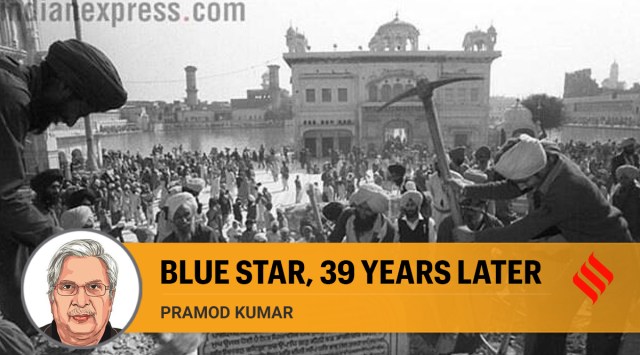
It is a testament to the deep meaning and significance of Operation Blue Star that its reverberations continue to be felt. On its 39th anniversary, the people of Punjab pay tribute to the lives lost and remember the pain experienced by individuals and communities. The event left an indelible mark on the collective memory of the nation, whether it was due to the Centre’s decision to direct the army to enter the precincts of the Golden Temple complex, or its aftermath that left a trail of violence, bitterness and a sense of betrayal within the Sikh community.
Decades later, Operation Blue Star has become a reminder of the need for respecting religious symbols, rather than a marker of social divisiveness, the politics of religious dominance or the assertion of the notion of a theocratic state. Operation Blue Star has also introduced restraint on the part of the state when confronted with similar situations subsequently, as was reflected in the handling of the Hazratbal issue and even after the demolition of the Babri Masjid. This transformed the significance of the event from being a source of justification for revenge for the “hurt Sikh psyche” into an ongoing political discussion on the relevance of the rights of religious groups in a diverse democracy.
The hurt felt by members of the Sikh community and secular-minded citizens touched a universal chord. It transcended the boundaries of religion, region, political and social affiliations. The stature of leaders like Indira Gandhi and Rajiv Gandhi was diminished. If Jarnail Singh Bhindranwale could not become an unquestioned icon of the Sikh masses, the former Indian prime ministers on whose watch Operation Blue Star and November 1984’s violence against Sikhs took place have been tainted in the secular and democratic matrix.
Separatist fringe groups have made it a ritual to raise pro-Khalistan slogans to commemorate this day. Through the holding of congregations of Sikhs, and through the loud claims of hardliners of custodianship of Sikh religious institutions and the SGPC, efforts are made to try and disturb the peace. This is mainly because no concerted efforts have been made to reduce incentives to violence and delegitimise it, and to deliver restorative justice. In other words, the obvious goals of closure — that is, transparency, justice and reconciliation — have not been addressed adequately.
The consensus in the country to ensure justice for Sikhs for the dreadful 1984 violence was extended to the rehabilitation of former terrorists. This was reinforced by eventually conceding (in 2014) the twice-denied appeal of Dal Khalsa, a radical Sikh organisation, for conferment of martyrdom on pro-Khalistan leaders by the Akal Takht. These organisations, having acquired a modicum of space and a veneer of legitimacy, raised their claim to control over the SGPC and the Akal Takht and their “liberation” from the moderates and liberals.
The state, on the one hand, allowed the regrouping of fundamentalist outfits in order to coopt and appropriate the religious or panthic constituency, and on the other, its inept and inefficient handling of the violation of the sanctity of Sikh religious scriptures provided fodder to fringe groups to articulate their divisive agenda in mainstream politics. In the backdrop to all this was the absence of a counter narrative to “Khalistan”. It is urgent that a counter narrative to religious fundamentalists is promoted and an alternative political discourse is nurtured to commemorate Punjab’s spirit of perseverance and to reflect its innate multi-culturalism.
No doubt, the delay in the delivery of justice to victims of violence has been used by some as a justification to take the law into their own hands. For example, there have been incidents in which men were lynched over incidents of suspected sacrilege, rather than bringing them to justice by law. This amounts to the legitimisation of violence.
Closure does not mean revenge and it also does not mean a claim that “my” use of violence is privileged and above the law. The assertion that the violent acts of non-state actors must be pardoned while state actors involved in violence must be punished is nothing but a subversion of justice, not closure.
The main focus of closure should be a recognition that atrocities were committed and the “willingness to live with truth”. This may involve setting up of documentation centres, and a Museum of Memories. This will create an understanding, and some degree of justice and reconciliation. It is never too late to work for the elimination of those conditions that create violence.
The demand for setting up a monument in the memory of the victims of the November 1984 violence in Delhi should be extended to include communal riots in general, including Partition riots. A national monument must be constructed in the memory of victims of communally divisive politics, which will act as a reminder not to indulge in political misadventures in the future.
These tragic events require a justice-oriented political response. On the contrary, in reality, we see the attempt to take refuge behind the rule-book to defend criminal acts of people in power. The legal recourse is used to make humane, ethical and moral responses redundant. We have witnessed it in the recent past in the case of the year-long farmers’ agitation, and now the protests by the women wrestlers. The lesson is that conflicts shall continue to simmer if they are faced with bureaucratic indifference, a legalistic approach and a commitment to the status quo. History should be used to learn lessons, rather than to teach a lesson.
The writer is chairperson, Institute for Development and Communication, Chandigarh